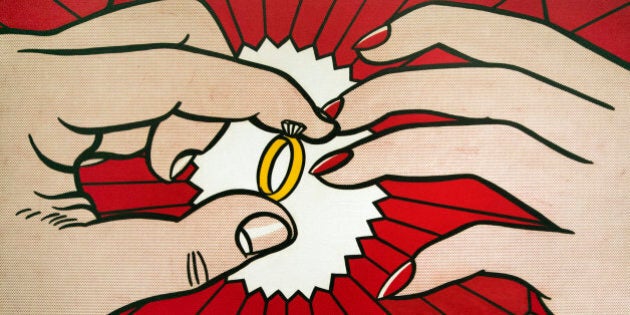
The night is quiet and cool. He or she slowly drops to one knee. A gleaming diamond ring is held aloft, and the warm tears start to flow. Yes, the moment when someone proposes marriage is truly unforgettable. But people have not always proposed in this way. Rather, over the centuries, engagements have begun in some really odd ways.
Love Does Strange Things
According to legend, some cavemen "proposed" by making ropes out of grass and fastening them around their love interests' hands and feet. Such a prehistoric man thought that he could dominate her spirit by doing so. This practice brings new meaning to the phrase "tying the knot."
Later, many men in ancient Greece gently tossed apples to the women they wanted to marry. Mythology inspired this custom. Eris, the goddess of chaos, threw a golden apple at Peleus and Thetis' wedding guests; she was angry because she wasn't invited. According to the message that Eris wrote on that fruit, it was a gift for the most beautiful person there.
Ancient marriage proposals aren't entirely different from ours. The engagement ring may have originated in ancient Rome. This ring was made of iron and worn on the left middle finger. For some reason, the Romans believed that a vein connected that finger to the heart.
Sign on the Dotted Line
For much of human history -- including in ancient Egypt and throughout the Middle Ages and Renaissance -- marriage proposals as we know them hardly ever happened. That's because marriage was more of a legal and financial arrangement than a romantic partnering.
Under this system, people often chose spouses for their children. A groom or his parents would negotiate in private with the bride's parents. They'd work out economic issues like the size of the bride's dowry, which was the money and land that a woman gave to her husband. In many cases, a woman wouldn't even meet the groom before she took her vows. If a husband and wife were lucky, they'd at least develop a friendship over the course of their marriage.
In medieval times, boys who were about 17 years old often got married as did girls who were just 12 or 13. Also, as soon as two sets of parents agreed on the terms of their children's marriage, they'd hang an engagement announcement on the local church's door. If anyone in town had a reason to oppose that union, they'd have to bring it to the families' attention.
At the close of the Middle Ages, Austria's Archduke Maximilian set a lasting romantic example. When he proposed to Mary of Burgundy in the 1470s, he gave her a ring with flat diamonds; they were arranged to look like the letter M.
On Bended Knees
Obviously, societies progressed over time. By the 1700s, people in industrialized nations started seeing themselves as individuals, and personal happiness became a goal for many. Therefore, men and women began to marry for love.
Another breakthrough came during the 1800s: Men in Europe and the U.S. began kneeling when they proposed. This gesture mimicked a tradition from the Middle Ages. That is, a knight typically knelt before the woman he was vowing to protect and serve. But not all men were that romantic back then. Believe it or not, it was acceptable in those days for a man to have a friend pop the question for him.
An Ad Campaign Changes Everything
De Beers Diamond Jewellery has had a huge effect on marriage proposals. The British entrepreneur Cecil Rhodes founded this company in South Africa in 1888. During the late 1930s, De Beers hired N. W. Ayer & Son, a leading advertising agency. In 1939, that ad firm began promoting diamond rings in magazines.
In 1948, it introduced a slogan that's still in use: "A diamond is forever." Once N. W. Ayer & Son popularized that saying, diamond engagement rings became the standard.
Recent Proposals
Since the "diamonds are forever" campaign, marriage proposals have become milestones in life. Modern trends are making them even more special. For example, many people now fly to romantic locations like Hawaii, Paris, and San Francisco for this occasion. Others organize flash mobs or record the event for social media.
An exciting way to video a proposal is to use the Ring Cam, an exclusive new product from Paris Jewellers. This small, high-quality camera is embedded in a ring box, and it will capture the reaction from an enchanting vantage point. The footage will surely move everyone who watches it.
Finally, what's the best time of the year to ask someone to marry you? These days, the period that begins on Thanksgiving and ends on Valentine's Day is when most proposals take place. Many people like to announce their engagements to friends and relatives during holiday gatherings. What's more, Christmas Eve and Jan. 2 are especially popular days for proposals. After all, once holiday preparations are finished, people can devote their full attention to their wedding plans.
MORE ON HUFFPOST:
